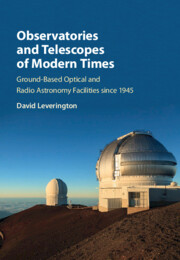 Observatories and Telescopes of Modern Times
Observatories and Telescopes of Modern Times from Part 2 - Radio Observatories
Published online by Cambridge University Press: 15 December 2016
US Naval Research Laboratory
Just after the end of the Second World War John Hagan, the head of the Centimeter-Wave Research Branch of the US Naval Research Laboratory (NRL), was looking for a new field of research in which to use his branch's experience. As a result he hit on the idea of observing astronomical sources of radio emission. Consequently Hagen and his deputy, Fred Haddock, decided to observe the Sun, not only because of its effect on the Earth's atmosphere, but because it was probably the only astronomical source observable with their type of equipment.
For their first solar observations Hagen and Haddock used parabolic antennae up to 10 ft (3 m) in diameter with receivers operating at wavelengths of 8.5 mm, 3.2 cm and 9.4 cm (frequencies of 35, 9.4 and 3.2 GHz respectively). Then in 1947 they went further and used an 8 ft diameter antenna to observe a total solar eclipse at a wavelength of 3.2 cm from on board ship in the South Atlantic. As a result they were able to conclude that the Sun, at this wavelength, was only slightly larger than the optical Sun.(1)
Unfortunately Hagen and Haddock's equipment only enabled them to observe the emission from the Sun as a whole as it did not have enough resolution to locate the exact sources of radio emission. It was clear that to locate these sources they would need a much larger dish. And if they managed to procure one they may also be able to observe other cosmic sources, as well as detecting thermal radio emission from the planets. So in the late 1940s Hagen and Haddock managed to persuade the US Navy to provide $100,000 for its purchase and, as a result, they were able to acquire a 50 ft (15 m) parabolic reflector from the Collins Radio Company designed by Ned Ashton of the University of Iowa.
This 50 ft NRL dish was made of 30 aluminium sector castings which had been bolted together. The surface was then machined to its parabolic shape to enable it to be used at wavelengths as low as 1 cm.
To save this book to your Kindle, first ensure [email protected] is added to your Approved Personal Document E-mail List under your Personal Document Settings on the Manage Your Content and Devices page of your Amazon account. Then enter the ‘name’ part of your Kindle email address below. Find out more about saving to your Kindle.
Note you can select to save to either the @free.kindle.com or @kindle.com variations. ‘@free.kindle.com’ emails are free but can only be saved to your device when it is connected to wi-fi. ‘@kindle.com’ emails can be delivered even when you are not connected to wi-fi, but note that service fees apply.
Find out more about the Kindle Personal Document Service.
To save content items to your account, please confirm that you agree to abide by our usage policies. If this is the first time you use this feature, you will be asked to authorise Cambridge Core to connect with your account. Find out more about saving content to Dropbox.
To save content items to your account, please confirm that you agree to abide by our usage policies. If this is the first time you use this feature, you will be asked to authorise Cambridge Core to connect with your account. Find out more about saving content to Google Drive.